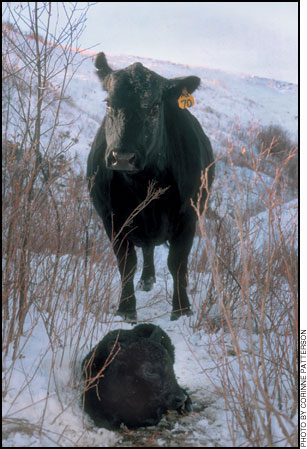Feeling the Chill
Calves that become too chilled at birth, without immediate assistance to warm and dry them and to make sure they ingest colostrum in a timely manner, have poor survival rates. Newborn calves can handle relatively cold temperatures, notes Russ Daly, South Dakota State University Extension veterinarian. But if there's wind and precipitation, it can be a different story.
"They lose too much body heat from being wet. They need to be dried off as soon as possible," says Daly. "I'd worry more about 32° temperature with wind and precipitation than a colder day with no wind."
Those calves on the edge of hypothermia are the hardest to distinguish, says Daly. "You can tell when calves are really cold, and you can usually tell when calves will be all right, but borderline calves may be hard to determine."
Daly says many ranchers stick a finger in a calf's mouth to see how cold it is. If the calf hasn't nursed, the inside of its mouth will usually be cold. He encourages producers to get a little more concrete evidence by using a rectal thermometer.
"Any calf whose rectal temperature is below 100° F could benefit from being warmed and a supplemental dose of colostrum," Daly says. (See "Calf Warming Boxes.")
You can often reverse frostbite with warm water if a calf hasn't been cold too long, Daly shares. "The key is warm water, not hot. And you don't want to rub very much because those tissues may be damaged from freezing and you could damage them worse."
While purebred breeders "are diligent to prevent frostbitten ears and tails for cosmetic reasons," frozen feet are a more crucial issue, Daly says. "Most calves I've seen with frozen feet were debilitated from some other reason, like scours."
The dehydrated calf has less blood flow to extremities; its limbs become cold and more vulnerable to freezing. If a calf is sick, it usually spends too much time lying down. It may not be able to get up and walk around, which would increase circulation, and blood perfusion to the limbs is severely compromised. The calf's feet could freeze at temperatures that would not be dangerous to a normal, healthy calf.
[Click here to go to the top of the page.]







